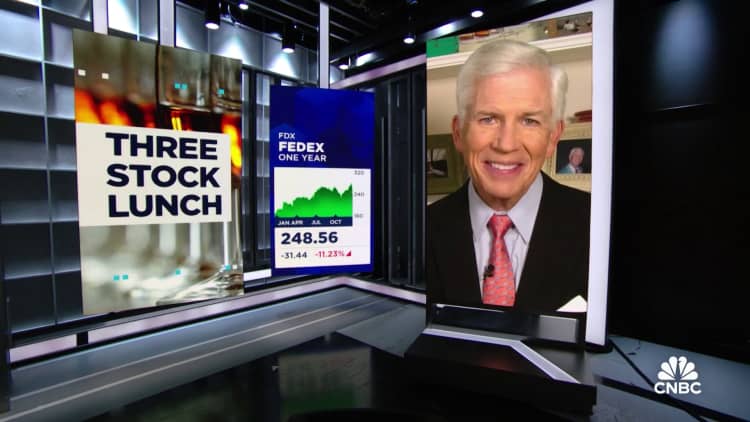Investor Michael Farr is back with his top 10 stocks he's buying for 2024, and the tilt is defensive
[ad_1]
Traders work on the floor of the New York Stock Exchange (NYSE) on the first day back since the Christmas holiday on December 26, 2023 in New York City.
Spencer Platt | Getty Images News | Getty Images
In each of the past 16 Decembers I have selected and invested personally in 10 of the stocks we follow with the intention of holding for just one year.
These are companies that I find especially attractive in light of their valuations or their potential to benefit from economic developments. I hold an equal dollar amount in each of the positions for the following year, and then I reinvest in the new list.
This year’s list is perhaps a bit more defensive than in years past, as seen by the number of medical device companies, and has a focus on earnings growth.
Results have been good in some years and not as good in others. I will sell my 2023 names on Friday and buy the following names that afternoon.
I will sell my 2023 Top Ten List at year-end and purchase the 2024 Top Ten on Jan. 2 to be sold at the beginning of trading in 2025. The following is my Top Ten for 2024, listed in random order:
Founded in 1915, Donaldson is a global manufacturer of filtration systems and replacement parts for engines, industrial plants, power generation and various life sciences applications. The company has dominant market share in many of its businesses, which are diverse by geography and end-market and have attractive long-term secular growth potential.
Valmont Industries is a relatively small company ($4.7 billion market cap) that manufactures engineered poles, towers and other structures for a number of different applications, including roads and highway safety, utilities, telecommunications, and access systems for construction sites.
We view the company as an investment in infrastructure development that should benefit from the long-term global secular trends of population growth, urbanization and water scarcity.
The company’s major business activities include debt and equity underwriting, M&A advisory, asset management, trading, lending and proprietary investing. The stock has been highly volatile over the past couple of years, due largely to an ill-conceived decision to more aggressively target the consumer lending market.

The rationale behind this decision was sound – consumer banking activities generally produce more dependable and recurring revenue streams, which are rewarded by investors in the form of higher valuations (trading multiples). However, management’s timing could not have been much worse, while execution was poor at best.
Following the separation of its Environmental and Applied Solutions businesses on Sept. 30, Danaher has become a pure-play biotechnology, life sciences and diagnostics company. The company’s evolution to its current state occurred through a long series of acquisitions and divestitures designed to generate shareholder value through the application of the company’s proprietary set of operating processes and tools it refers to as the Danaher Business System, or “DBS.”
Amazon excels in three areas where we see ample secular tail winds: cloud computing, e-commerce and digital advertising. Perhaps more importantly, each of these businesses has a wide economic moat.
PepsiCo is a leading multinational snacking and beverage manufacturer that has seen a significant improvement in operational execution since CEO Ramon Laguarta took over in 2018. Laguarta has transformed Pepsi into a “faster, stronger, and better” company through several strategic initiatives: 1) reinvesting into the company’s brands via innovation and marketing; 2) addressing portfolio gaps in fast-growing categories where the company had been underpenetrated; and 3) enhancing the supply chain by increasing manufacturing capacity and introducing efficiencies through technological investments.
The Walt Disney Co. is one of the most prestigious brands in the world. Over the past century, the company has evolved from a small animation studio to a vertically integrated media and entertainment conglomerate. Disney has faced its fair share of challenges over the past couple of years, including a botched succession, an acceleration in cord-cutting and a slow recovery at the box office. Offsetting these challenges has been the resilient, and highly profitable, Parks & Resorts business which has benefited immensely from pent-up demand coming out of the pandemic.
Abbott Laboratories is a best-in-class Medical Device company that is diversified across four segments: Medical Devices, Diagnostics, Nutrition and Established Pharmaceuticals. The company has a compelling mix of existing products that are generating durable growth today, and new/upcoming product launches that will support future growth.
Johnson & Johnson is one of the world’s largest and most diversified healthcare companies. Following the recent Kenvue spinoff (consumer health business), JNJ’s revenue base now consists of 65% from the pharmaceutical segment and 35% from the medical technology segment (MedTech). The company is expected to continue benefiting from an aging global population and rising standards of living in emerging economies.
Microsoft is one of the largest technology companies in the world. It has successfully pivoted from a Windows PC-first world to the cloud and is leading the way in generative artificial intelligence. The company is a strategic partner in enterprise digital transformations through its cloud, app and infrastructure, and artificial intelligence offerings.
The reader should not assume that an investment in the securities identified was or will be profitable. These are not recommendations to buy or sell securities. There is risk of losing principal. Past performance is no indication of future results. If you are interested in any of these names, please call your financial advisor to discuss.
[ad_2]




